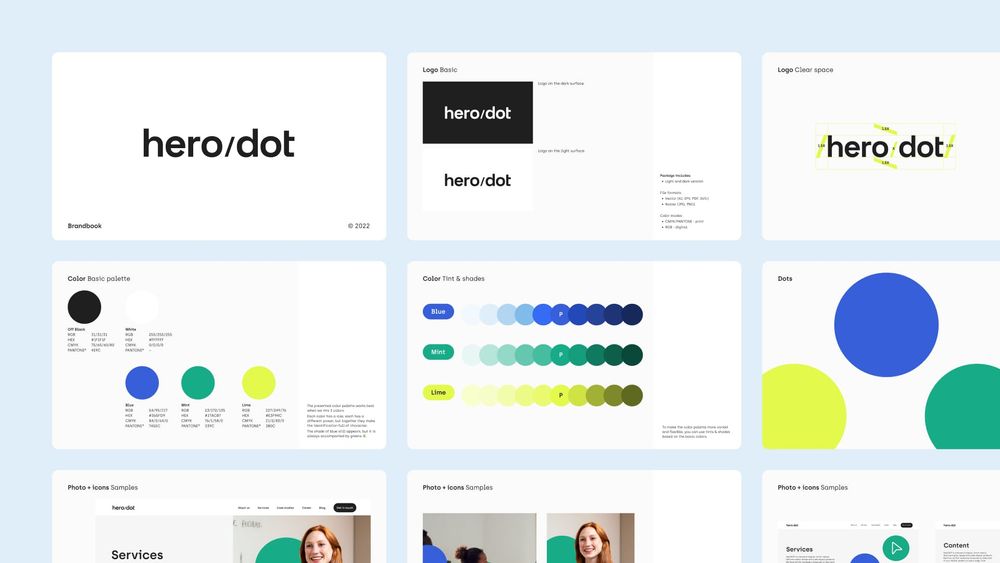Brand Identity – A 6-Steps Beginner's Guide

Michał Wapiński

What is brand identity? Basically, it makes for the face of your brand. It’s a component that stands for the emotional and professional part of the company’s image. It’s essential to have a consistent brand identity as it’s reinforcing the associations your firm will have in your customers’ minds. A message portrayed by its components needs to be compatible with the values represented by the goods and services you offer.
Brand identity affects how your business partners and customers look at you, feel you and speak to others about you. Sometimes it may even include how your brand sounds, tastes and smells to them! Brand identity seems to be the best way for all companies (both startups and small businesses as well as large corporations) to create a competitive edge over others, even in a crowded marketplace.
Here's a comprehensive guide on creating a strong and clear brand identity for your business, organisation, or product.
Launching a New Brand Identity Concept
#1 Analyse Market and Consumers
Working on brand identity should always begin with analysing the market and your customers. You need to understand what they expect from your company and what image you should build. An experienced business partner will offer you a joint analysis of your market. But first, make sure that you have gathered all the data you could get about your consumers’ preferences and behaviour.
 If brands are like people, brand identity makes for their faces.
If brands are like people, brand identity makes for their faces.
If you aren’t sure what to do first, always start with benchmarking your competitors. Check what solutions they’ve already introduced and what’s their efficiency. Examine your users and consumers in the most detailed possible way. Find the best standards on the market. Think about what you could add to stand out from the rest.
From the business perspective, a good practice worth applying is creating “personas”. A buyer “persona” is a semi-fictional representation of an ideal customer. It may include customer demographics, interests, pain points, behaviour patterns, motivations, and goals. Preparing it will facilitate you coming up with an idea of what your brand identity should contain to have a positive impact on your customers.
#2 Choose a Look & Feel Design Process for Your Brand
Look & feel is a brand identity design process that stands for displaying a visual representation of the image that your brand will have (before actually working out the final details!). It allows you to prototype how the consumers of your products will perceive your design choices and how they will feel when interacting with your brand. It’s a smooth “creative direction”, which shows the general course that your brand will take.
 Look&Feel: a mural branded to advertise Tak Innovation.
Look&Feel: a mural branded to advertise Tak Innovation.
We can divide the look & feel design process into two parts.
Part 1: All the ingredients of your brand identity
The first one might be defined by the primary visual and communicational components that you need to have to create a clear and compatible brand identity:
- Colour palette,
- Mood boards,
- Set of graphics,
- Layouts,
- Brand direction shots,
- Fonts.
Part 2: Make sure your brand identity is delicious
What can you do to be certain that a given look & feel will be adequate for you? It should be presented in contexts in which your brand indeed appears. If you run campaigns on physical media, it should show specifically what your outdoor advertising will look like. Analogically, if you're advertising mainly digitally, it should give you the feel of your social media campaigns.
Therefore, the second part of the look & feel design process refers to the use of graphic elements on various media. In this way, you’ll be able to check how your future design adapts to the changes in the surroundings. It’ll show what feelings your customers and users will get if your brand appears on:
- Billboards,
- Posters,
- Advertisements,
- Conferences,
- Murals,
- Business cards and badges.
Depending on how you approach your brand identity, your tone of expression, the perceived power of your communication, and the compatibility of your messages will be differently received. Remember about the tone of voice you want to apply - include it in the process of brand identity creation.
The look & feel design process has a vital role from a business perspective. To sum up, let's take a look at what it does:
- visibly and explicitly shows if your branding is applicable on different platforms and products,
- allows youto visualise what the brand identity will look like in the future,
- has significant presentation value,
- maximases the effectivness of designer's work by setting the right Art Direction at the very beggining of the process.
#3 Create an Adequate, Pleasant and “Flexible” Logo
Depending on the project, a new logo might be included in the look & feel, but as it’s ordinarily one of the critical parts of brand identity, it should be given special attention. The logo is, primarily, an identifying factor. It’s a tool that contributes a lot to brand recognition.
Even though you’ll find a lot of decent articles about the value of logos in communication, you shouldn’t forget about the identification part. An excellent designers’ team will prepare for you a logo that will be appropriate, recognisable and simple. This graphic symbol should immediately associate the user with your brand.
It’s essential to create a logo that is easy to recognise and adequate to the market you focus your efforts on. Additionally, such a logo is created in a way that will allow it to be applied wherever you need it. Flexibility at every scale and in every place is a game-changer.
 To give you an example, look at this flexible logo of Space Digital Group.
To give you an example, look at this flexible logo of Space Digital Group.
The logo must be either visible at every scale and from every distance or be in a couple of compatible versions. If you go for the second option, make sure that you can use them in a different scope and to a different degree of detail. It’s often found that the logos are pleasant but hard to use. Top-quality designing specialists will remember that the customer must use logos on different media channels and products with all sorts of structures.
#4 Prepare Design Assets
Have you accepted the new look & feel of your brand? Do you agree that your new image perfectly meets your needs? If you answered 'yes' to both of these questions, it’s time for the designers to transfer you the production files. They will allow you to directly implement a new brand identity on various projects.
Depending on your needs, the agency should provide the logo in raster and vector forms with different colour versions and formats. In addition, it should supply fonts, applications, business card designs and more in editable AI, PSD, Sketch files (or others if necessary).

 Compare these examples of branded HeroDot graphics: what sort of similarities and differences can you see?
Compare these examples of branded HeroDot graphics: what sort of similarities and differences can you see?
Colour palette, animations, photos (also with appropriate filter generators), graphic materials, logos in several variants, visual-3D materials, fonts, motion designs, all the other visual design assets... That’s the thing that we already have at this point of creating a new brand identity.
Skilful designers will prepare for you graphic production materials that can be used straight away. You, as a customer, need to get files from a designing company so that you can start using them immediately. Besides, to benefit from them appropriately and efficiently, you should know the rules and concepts of the creators.
#5 Set Brand Identity Guidelines
The agency's task is to prepare not only the “blocks” that make up the new brand identity but also the instructions on how to use them. The brand identity set will be implemented by various designers, who won’t be able to read the minds of its creators.
You need to receive all the possible tools and directives to build your projects consistently and maintain the same quality over a long period of time. That’s why it’s so pivotal to provide specific guidelines and hints on the limitations and, predominantly, all the opportunities that your new brand identity has.
- When do we use particular fonts?
- What is the tone of voice in different situations?
- When should we use the lighter or darker layouts?
The answers to all of such questions should appear in the Brand Identity Guidelines.

Brand Identity Guidelines is a set of rules collected in the form of a website or PDF, which provides detailed instructions on the use of the files prepared by the designing agency. It explains, step by step, how to use the new brand identity so that it stays consistent. If it’s well-prepared, it guarantees a compatible identification and communication of your brand. And so, it increases the likelihood of success, if your new brand identity scheme used optimally.
#6 Consider Creating a Position of Art Director
Another good practice is signing a short-term deal with one of the creators to make him or her act as an Art Director or Consultant. For some time, such a person would be responsible for teaching your employees how to properly use the designs to achieve the right long-term effects.
Moreover, he or she will check the correctness of your employees’ projects and help them with adjusting their new ideas to the borders set by the new brand identity. Once they thoroughly learn it, it will be much easier for your brand to be consistent and clear with the message displayed and values provided.
Conclusion
Remember that a logo and a colour palette alone do not make a brand identity. If you aim to do it properly, you need to create a comprehensive visual language. Remember that you will place it on everything: from your mobile application through conference badges, up to a branded cup. Depending on your brand values, market type, and consumers behaviour, your needs may vary. You should invest your time and money properly to achieve the best results.
In many cases, the process of creating a brand identity can be long, expensive and complicated. We are aware that for many beginning businesses with a smaller budget, it may simply lack the sense to use the full-fledged process. The step that some companies take is hiring a cheap, less experienced designer, whose work simply misses the mark.
However, by using experience in designing complex identifications for large customers, HeroDOT is able to cut the process to an absolute minimum. At low costs and with a short implementation time our solution will bring you great results. Even if you do not have a large budget and time to carry out the full process of building the image - you can still get the highest level design, tailor-made for a smaller business.
Are you interested in ordering the set that will facilitate the process of creating a new brand identity? Check our offer here.
Need expert assistance with your digital project?
Recent from Michał Wapiński
You may also like


